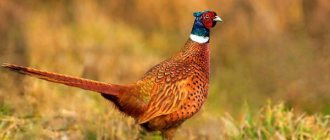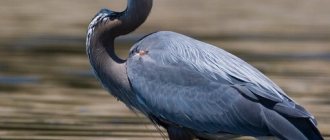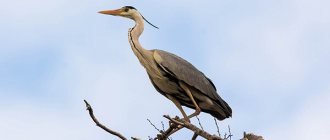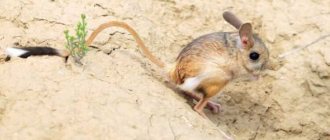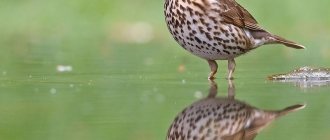- Wild animals
- >>
- Birds
The gray heron is one of the most common representatives of storks. It lives mainly on the territory of Belarus in swampy regions. This is a rather large and very beautiful bird. In addition to Belarus, it can be found in some regions of Eurasia and even in Africa. The name of the species translated into Russian means “ashen bird”.
Kinds
This is a fairly common bird - the heron. Descriptions and species are presented in almost all ornithological reference books. Numerous species of herons differ not only in color, but also in size, which can vary: from forty centimeters to one and a half meters. The average weight of birds does not exceed two and a half kilograms.
Representatives of different species usually have a single color: white, red, black, gray, but there are also two-colored herons. Most often, the paws are painted a darker color. The plumage is smooth, and the head is often decorated with a crest. Its size depends on the species.
Today there are fourteen main species of these birds. The most famous of them:
- black;
- big blue;
- red heron;
- black-necked;
- white;
- gray heron.
We will talk about the latter type in more detail.
Gray Heron: description
This is one of the largest representatives of the family. The bird's weight reaches two kilograms, its body length is slightly more than a meter, its wingspan is from 1.5 to 1.75 m. The bird's head is narrow, decorated with a large pinkish beak that resembles a dagger. It is very sharp and long - up to thirteen centimeters.
On the back of the head there is a “pigtail” - a black bunch of feathers hanging down. The neck is long and very flexible. The head, neck and lower part of the body are painted off-white, with dark streaks visible on the front. On the rest of the body, the feathers are gray with a bluish tint. The paws are also gray, but have a yellow tint.
During the mating season, the gray heron looks especially impressive: the beak becomes much brighter, and the characteristic “pigtail” blooms. The iris of the eyes is yellow, with a greenish tint. The unfeathered rings around the eyes are greenish.
In flight, the gray heron folds its neck, which takes the shape of the letter S so that its head lies on its back. At the same time, the legs extend far beyond the end of the tail. That is why the silhouette of a flying bird is somewhat humpbacked, with a protrusion that forms the bend of the neck. This is the main difference between the heron and other long-necked birds - cranes, storks, which keep their neck straight in flight, and their head protrudes far forward.
On the belly, chest and groin, the tips of the feathers often break off and crumble into small scales, turning into a special powder that herons sprinkle on their feathers. This procedure is necessary so that they do not stick together due to fish mucus. Ornithologists call this powder powder, which is found in all types of herons. This peculiar heron powder is applied using an elongated, jagged claw on the middle finger.
There is no sexual dimorphism in the color of the gray heron; the birds differ only in size: males are noticeably larger than females.
Habitat
Now let’s find out where the gray heron lives. This species is distributed in Asia and Europe: from the shores of the Atlantic Ocean, the Japanese Islands and to Sakhalin, in the south to Sri Lanka and North-West Africa, in the north to Yakutsk and St. Petersburg. Usually breeds in Madagascar. Winters in many regions of India, Indochina and Africa.
Probably, many of our readers well remember Nikita Mikhalkov’s soulful performance of the song in the film “Cruel Romance”, which contains the following lines:
“The furry bumblebee is for fragrant hops,
Gray heron - in the reeds..."
Indeed, in many regions, the heron of this species prefers to build nests in the reeds, for example in Turkmenistan. In addition, their nests can be seen in trees.
Bird distribution
The gray heron is widespread throughout Eurasia, up to the middle taiga, except in deserts and highlands. The south of the range includes the African coast of the Mediterranean Sea and southeast Asia. Sometimes the bird nests in eastern and southern Africa, Madagascar, Sri Lanka, the Maldives and the Greater Sunda Islands
Gray herons do not fly into the mountains above 1000 m above sea level, but always live near fresh water bodies, less often near seas or salt lakes. In shallow areas of reservoirs, herons forage for food.
In central and southern Europe, herons lead a sedentary lifestyle, occasionally migrating to the south. Birds living in Russia migrate to Africa for the winter. Central Asian populations migrate to India and China.
Gray Heron: type of chicks
It should be noted that gray herons are excellent parents. They share all the worries about breeding offspring equally. Together they build a nest in trees, large bushes, in thickets of reeds or reeds. It has the shape of an upside down cone.
At intervals of two days, the female lays from four to six eggs, which are colored greenish-blue. Like all representatives of the order Anodidae, the brood of this species is of the nestling type. In other words, the chicks are born naked and completely helpless, but at the same time sighted. From the first minutes they need the care and increased attention of their parents.
After the first egg is laid, the parents begin to incubate it, and both the female and the male do this alternately. Perhaps this is why the firstborn is always the largest. When all the chicks hatch, caring parents feed them together. After seven to nine days, the chicks begin to develop their first feathers, and within two weeks they are on their feet.
Reproduction and parental behavior
The gray heron is a monogamous bird, however, there are different opinions regarding the duration of pair maintenance. According to some sources, couples are permanent, according to others, they remain only for one season. Sexual maturity in females occurs at one year of age, in males - at 2 years, however, not all young ones begin to reproduce at this age.
In places where migratory populations live, herons begin nest-building immediately after arrival (late March - early April). In countries with a tropical climate, there is no clear seasonality in the breeding of herons. The male is the first to begin building a new or repairing an old nest. Having done a small part of the work, he calls the female to the nest. Standing on the nest, it opens its wings, throws back its head and emits special croaking cries. But he first beats the arriving female and drives her away from the nest, and this ritual of mating behavior is repeated several times. It is interesting that the later the female arrives, the sooner the male allows her to the nest.
Gray herons make nests in tall trees (at a height of up to 50 m), but often on bushes or on the ground (on reed creases). If other birds also nest in the colony, the nests of gray herons are located highest. Both the male and the female build the nest. Usually the male brings building material, and the female lays it down and protects the nest from attacks by neighbors. When building a nest in trees and bushes, herons use thin dry branches and, in small quantities, dry stems of reeds and cattails. Most often, the gray heron's nest is made very carelessly with large holes at the bottom and along the walls. The height of the nest is on average 50-60 cm, diameter 60-80 cm, but old nests are often much larger. In large colonies, nests are built more carelessly, while in single pairs they are more thoroughly built. The attachment of herons to the nesting site is very high. Often nests are used for several years and are only renewed annually. This constancy is also inherent in colonies, which have been located in the same places for tens (and sometimes hundreds) of years.
A gray heron's clutch contains from 3 to 9 eggs, most often 5 or 6. The color of the eggs is greenish or blue. Eggs are laid at intervals of two days, and incubation begins with the first egg, so the chicks in heron nests are of different ages. Incubation lasts 26-27 days in countries with a temperate climate and 21 days in tropical parts of the range. Both parents incubate, but the female spends more time on the nest.
Like all representatives of the order Storkidae, the chicks of gray herons belong to the nestling type, i.e. they are born practically naked and helpless (but sighted). Such a chick weighs 40-45 g. Then the chicks are covered with gray down, and their feathers begin to grow at 7-9 days. Parents bring food to the chicks several times a day and regurgitate it from the stomach, since the food must be semi-digested. The chicks gain the bulk of their body weight before they fly, in the interval between 7 and 20 days. The average weight of a one-month-old chick is 1.1 kg, and a two-month-old chick is 1.6 kg. The entire feeding period lasts 50 days.
Mortality among gray heron chicks is very high, for example, in colonies on the Rybinsk Reservoir it is 46-50%. The reasons for this are very different: a general lack of food, competition between chicks of different ages for food, illness, etc. And besides, despite a fairly high degree of aggressiveness, gray herons are less inclined than other herons to both individual and collective protection of nests and chicks.
Lifestyle
For the most part, the gray heron is a nomadic or migratory bird. Only in some places does she live sedentary. In Russia, the gray heron is a typical long-distance migrant. An analysis of ringing carried out by ornithologists showed that the wintering places of the gray heron are scattered over a vast territory. For example, from Western Siberia and the European part of Russia, a large number of herons fly to wintering in Africa, south of the Sahara Desert.
The other part of this population does not go on such a long journey and remains for the winter in the countries of Southern and Western Europe. In Southeast and South Asia, Africa, and the Malay Archipelago, the gray heron leads either a sedentary or nomadic lifestyle. Most often, herons migrate in small groups, but sometimes they gather in large flocks of up to two hundred and fifty birds. Solitary herons on migration are extremely rare.
Taxonomy
Latin name
—Ardea cinerea
English name
— Gray (common) heron
Class
— Birds Aves
Squad
— Ciconiiformes
Family
— Herons Ardeidae
Genus
— Herons Ardea
The gray heron is one of the most typical and widespread species of stork-like or wavy-legged, as they were previously called because of their long legs. Currently, 4 subspecies are distinguished - Accinrea lives in the western part of the range east to the coast of the Caspian Sea and Trans-Urals; Acjouyi – in the eastern part of the range; Acfirasa - on the island of Madagascar; Acmonicae - in a limited area off the coast of Mauritania.
Flight to wintering
These birds fly at quite a high altitude, not only during the day, but also at night. The autumn migration usually takes place at dusk, after sunset, and during the day the flocks stop to rest and eat. When taking off, the great gray heron flaps its wings very quickly, and its legs hang freely in the air. Having gained the required height, the bird picks up its legs and then flies smoothly, with measured movements of its wings. Sometimes she floats in the air for a short time.
In flight, flocks of herons form a straight line or wedge. Gray herons nest in colonies, in which there are up to twenty nests. In Europe, where these birds are now protected, there are huge colonies consisting of thousands of nests. However, cases of separate nesting of pairs are not uncommon. Sometimes colonies are mixed: other species of herons, spoonbills, and ibises settle in them. In the central zone of our country, where other species of herons and ibises are not found, monospecific colonies are formed.
The gray heron can be active at any time of the day; they cannot be called either diurnal or nocturnal birds. During long-term observations, it was established that the time of these birds is distributed as follows:
- 77% of the time they hunt and are awake;
- Birds sleep 5.9% of the time;
- 16.6% are engaged in hygiene procedures.
Interesting data, isn't it? For a significant part of its life, the heron stands motionless, with its neck retracted, on one leg, and the other tucked in.
Gray herons have a well-developed system of visual signals. A long and flexible neck can express different emotions. For example, when threatening an enemy, a heron arches its neck, as if preparing to attack, and raises the crest on its head. Usually this pose is accompanied by a threatening cry. When birds greet each other, they quickly click their beaks. This clicking sound can also be heard during mating rituals.
When resting, the heron hides its head between its shoulder blades. Despite its rather large size, the heron is not easy to spot in natural conditions. A not very experienced and attentive researcher will notice it only when he gets very close to it. At this moment, the heron straightens its neck, loudly pronounces “krak” and immediately soars into the sky.
Nutrition
The diet of the gray heron consists only of animal food. This is an active, dexterous and extremely voracious predator. Its prey is any land or aquatic animal that the heron can physically cope with. But since these birds spend most of their lives near bodies of water, it is not difficult to guess what the gray heron eats.
The dominant position in their diet is occupied by fish, no longer than twenty-five centimeters and weighing no more than five hundred grams. The gray heron will not refuse frogs, various insects, crustaceans, and mollusks. On land, these are usually lizards and small rodents, snakes, large grasshoppers, beetles and locusts.
Natural enemies of herons
Herons are quite large and strong predators. What gives them an advantage is their strong beak, which can protect them from many enemies. Under natural conditions, herons are afraid of:
- Lisits.
- Birds of prey.
- Shakalov.
- Water rats.
Enemies can not only attack herons, but also break into their nests and eat eggs and newborn offspring. Birds themselves are often carriers of diseases, particularly parasites. This is due to their diet, which consists of fish and various crustaceans, which contain many parasites.
Climatic conditions also influence the decline in bird populations. Widespread climate change, a long cold spring with falling snow deprives birds of food, which is why a significant part of them die, since herons are not adapted to survive in such conditions.
How does a heron hunt?
The gray heron is a very agile and dexterous hunter. Moreover, in her arsenal there are many hunting methods, and they are all quite diverse. Interestingly, different individuals prefer to use their own methods of obtaining food. Most often, the heron stands motionless or slowly wanders through the shallow water, looking out for its prey.
Then there is a throw of the head on a fully straightened neck - and the prey is in the bird’s beak. Sometimes during such a hunt they open their wings. Perhaps in this way they scare away the prey or obscure the water to make it easier to see the prey.
Gray herons have also been observed in unseemly acts: they are not averse to stealing prey from their neighbors (gulls, cormorants). But sometimes smart crows steal from them too. Gray herons can hunt without moving away from the colony, or they can fly over considerable distances (up to thirty kilometers).
What does a heron eat in the wild?
Herons are birds of prey, so they feed on food of animal origin. Predators are quite active and voracious. Since birds prefer to settle near bodies of water, the main part of their diet consists of:
- Fish.
- Insects.
- Shellfish.
- Crustaceans.
- Lizards.
- Serpent.
- Aquatic vertebrates.
Herons can steal food from other birds, such as gulls or cormorants.
In an effort to get food, the heron freezes in one place or slowly walks back and forth. When the prey becomes noticeable, the bird makes a sharp, powerful lunge, straightening its neck and grabbing the prey. She swallows her prey whole, without cutting it up.
Sometimes, from the nesting site to the place of food production, herons have to make flights, the duration of which can reach 30 km. These birds live mainly on the shoreline of water bodies, so such flights are not always necessary.
Herons know how to catch prey in a rather cunning way. They enter the water and wait for a fish to come along. At this time, the bird moves its fingers, and the fish mistakes these movements for crawling worms and swims closer. When the prey is close enough, the heron grabs it and swallows it headlong.
Vocal data
The repertoire of gray herons is quite diverse, although ornithologists classify these birds as silent. Most often you can hear a rough and slightly rasping cry, reminiscent of the short croak of a crow. It is usually produced by herons in flight. It can be heard over a long distance.
Gray herons make all other sounds in the colony during nesting. A short cackle is an alarm signal; a long, vibrating throat sound indicates aggression. A dull short croak means that there is a male in the flock. Birds that gather in large groups within the colony constantly “negotiate” with each other, emitting croaking and croaking calls.
The story of life at the zoo
Now we have only one gray heron living in our zoo, and that one has an amputated wing. Such animals, damaged by collisions with vehicles, wounded animals, or in trouble for other reasons, are usually brought to the zoo by visitors. They are treated, but, as a rule, they are no longer capable of life in the wild. Therefore, we ask our visitors not to be indignant when they see “poor quality” animals in the enclosures. Their lives were saved, and now they are quietly living out their lives in warmth and care. Our Gray Heron can be seen at the Birds and Butterflies Pavilion in the New Territory. In summer she lives outside with other herons, and in winter she lives inside the pavilion. Her diet, as in nature, includes only animal food (100 g of meat, 300 g of fish, 2 mice and some gammarus crustaceans); in total no more than 500 g.
Conservation status
Today, gray heron numbers are quite high in almost all parts of its extensive range. Nowadays, in accordance with its international status, this bird is classified as a species whose existence does not cause serious concern. The total number of this species, according to the latest data, ranges from seven hundred thousand to three and a half million individuals. The most numerous populations of this bird are in Russia, Japan and China.
And just recently it was a rare species in need of protection. The gray heron in the Kirov region, for example, was listed in the regional Red Book in 2001. But already in the new edition (2011) this species was excluded from the list of protected species, since their numbers in the region had been restored.
However, in some regions of Russia the gray heron is still rare. The Red Book of Kamchatka has been replenished with this species, in accordance with the agreement between Russia, India and Japan on the protection of migratory birds.
Features of character and lifestyle
Photo: Gray Heron in flight
Depending on climatic conditions, the gray heron leads a nomadic or sedentary lifestyle. Birds living on the territory of the Russian Federation and Belarus always fly to warmer countries with the onset of the first autumn cold snap. This is due to the fact that the bird will not be able to provide itself with food in harsh winter conditions.
Bird migration occurs in small groups. In rare exceptions, the number of these flocks exceeds two hundred individuals. There are practically no single individuals encountered on migration. During the flight, they fly at great heights both day and night.
When living in their usual territory, they settle in groups, nest in separate colonies, forming several dozen nests in a relatively small area. Birds tend to form colonies with other species of storks, as well as other species of birds - storks, ibises.
The gray heron is not active at a strictly defined time of day. They can be very active both day and night. Most of the time they are awake and hunting. They also spend a lot of time cleaning their plumage.
Interesting Facts
- The largest heron in the world is the gray heron, which lives in the papyrus thickets of Africa. Its height is one hundred and forty centimeters.
- Gray herons of Central Europe are partially migratory, since not all birds fly south in winter. During particularly harsh and snowy winters, many birds remaining in their permanent habitats die of hunger.
- A heron always takes off very easily, even if it is in the water at the time of takeoff.
- A gray heron swallows a fish from its head. For this reason, scales, fish bones and fins never get stuck in her throat.
Shedding
Once a year, full annual, between July and November. According to Witherby (1939), birds in nesting plumage also have a partial molt of small feathers in the first autumn of life, between September and December. Scheme of age-related changes: first downy plumage - second downy plumage - nesting plumage - first annual plumage (final), etc. In the Ussuri region, gray herons begin to molt around July 20 (Shulpin, 1936). Probably, at a similar time, molting begins in other parts of the range. Molting is slow and ends at wintering sites.

